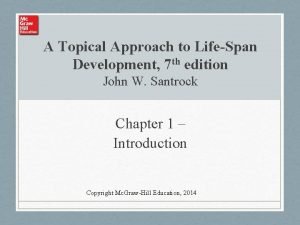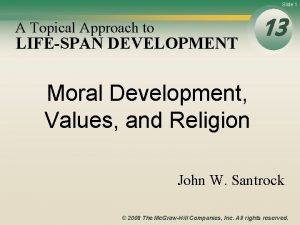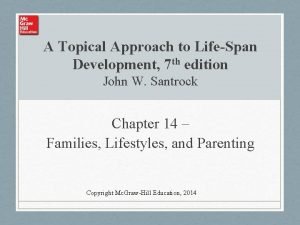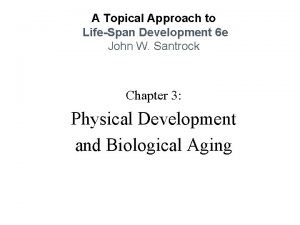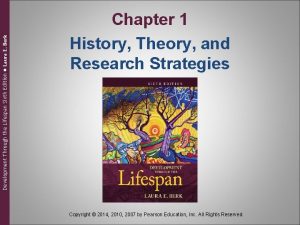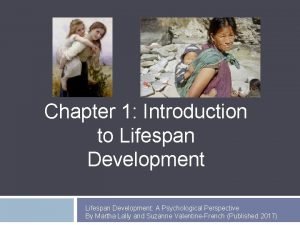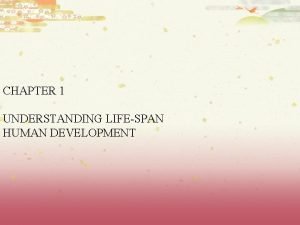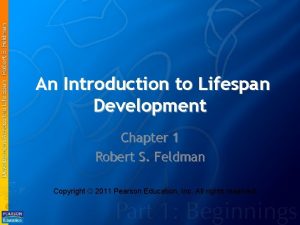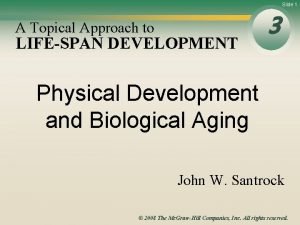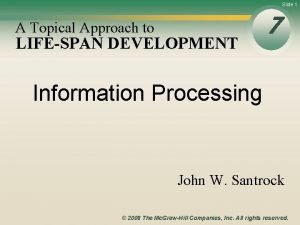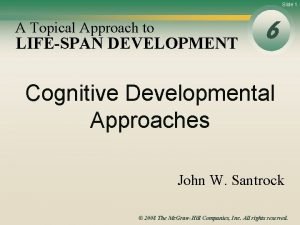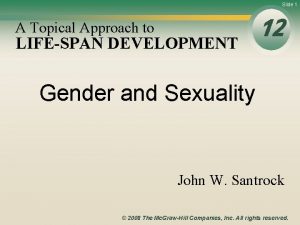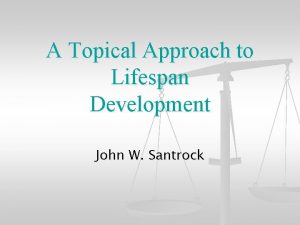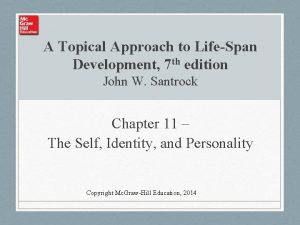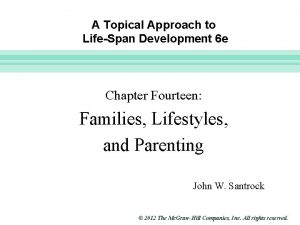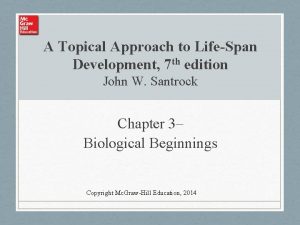A Topical Approach to LifeSpan Development 7 th















- Slides: 15

A Topical Approach to Life-Span Development, 7 th edition John W. Santrock Chapter 17 – Death, Dying, and Grieving Copyright Mc. Graw-Hill Education, 2014

The Death System and Cultural Contexts • Death occurs most often among older adults • In past, most people in U. S. died at home, cared for by family • A larger number of older adults die apart from their families • More than 80% of deaths occur in institutions or hospitals • Minimized exposure to death and painful surroundings Copyright Mc. Graw-Hill Education, 2014

Defining Death and Life/Death Issues • In past, the end of certain biological functions were considered clear signs of death • Breathing, blood pressure, rigidity of body (rigor mortis) • Brain death • Neurological definition of death • A person is brain dead when all electrical activity of brain ceases for a specific period of time • Higher brain regions may die but lower portions may continue breathing and heartbeat Copyright Mc. Graw-Hill Education, 2014

Defining Death and Life/Death Issues • Living will • Designed to be completed while individual can still think clearly • Expresses desires regarding extraordinary medical procedures that may sustain life when medical situation becomes hopeless • Hospice • Program committed to making end of life as free from pain, anxiety, and depression as possible • Emphasizes palliative care – reducing pain and suffering and helping individuals die with dignity Copyright Mc. Graw-Hill Education, 2014

Developmental Perspective on Death • In United States, deaths of older adults account for approximately ⅔ of the 2 million deaths that occur each year • What is known about death and grieving is based on information about older adults • Youthful death is much less common Copyright Mc. Graw-Hill Education, 2014

Developmental Perspective on Death • Death can occur at any point in life span • In childhood, death occurs most often due to accidents or illness • Major illnesses that cause death in children – heart disease, cancer, birth defects • Death in adolescence likely to occur because of motor vehicle accidents, homicide, suicide • Older adults are more likely to die from chronic diseases • Often incapacitated before death; produces a long course of dying Copyright Mc. Graw-Hill Education, 2014

Developmental Perspective on Death • Age influences the way death is thought about and experienced • Mature, adult-like conception of death includes: • An understanding that death is final and irreversible • Death represents end of life • All living things must die Copyright Mc. Graw-Hill Education, 2014

Developmental Perspective On Death • Infants experience brief separations as total losses • Loss of a parent can negatively affect infant’s health • In early childhood, children have little or no idea what death means • • Confuse death with sleep or ask “why doesn’t it move? ” Rarely get upset at death Believe that dead can be brought back to life Believe only people who want to die, who are bad or careless, actually die Copyright Mc. Graw-Hill Education, 2014

Developmental Perspective On Death • Children develop more realistic perceptions of death in middle and late childhood • Do not view death as universal and irreversible until about 9 years of age • Death of a parent is especially difficult for children • School performance and peer relationships often worsen • Death can devastate and result in hypersensitivity about death • Loss of sibling may cause similar outcomes Copyright Mc. Graw-Hill Education, 2014

Developmental Perspective On Death • Adolescents develop more abstract conceptions of death • Describe in terms of darkness, light, transition, or nothingness • Develop religious and philosophical views about nature of death or whether life exists after death • Not unusual for adolescents to believe they are immune to death or that it happens to other people, but not them Copyright Mc. Graw-Hill Education, 2014

Developmental Perspective On Death • Suicidal behavior escalates in adolescence and further increases in emerging adulthood • Far more adolescents think about or attempt suicide than complete attempts • Females are more likely to attempt suicide than males, but males more likely to succeed • Males use more lethal means in suicide attempts Copyright Mc. Graw-Hill Education, 2014

Developmental Perspective On Death • Suicidal behavior of adolescents also varies by ethnicity • Native American/Alaska Native adolescent females are most likely • African American males among the least likely • Depression is most frequently cited factor associated with adolescent suicide • Sense of hopelessness, low self-esteem, high self-blame • Suicides often occur in clusters • “Copycat” suicides raise issue of whether suicides should be reported in the media Copyright Mc. Graw-Hill Education, 2014

Developmental Perspective On Death Copyright Mc. Graw-Hill Education, 2014

Facing One’s Own Death • Kubler-Ross’ Stages of Dying: • • • Denial and isolation – denies death is taking place Anger – anger, resentment, rage, and envy Bargaining – develops hope that death can be delayed Depression – perceives certainty of death Acceptance – develops sense of peace, acceptance of one’s own fate, and often desire to be left alone • Some psychologists prefer to describe “stages” as potential reactions to dying because of criticisms Copyright Mc. Graw-Hill Education, 2014

Coping With Others’ Death • Grief • Emotional numbness, disbelief, separation anxiety, despair, sadness, and loneliness that accompany loss of loved one • Pining for lost person is important dimension of grief • Intermittent, recurrent wish or need to recover lost person • Feelings of grief occur repeatedly after a loss • As time passes, pining and protest over loss tend to diminish • Becomes more manageable over time, with fewer abrupt highs and lows but TOO MANY VARIABLES. • Bereavement Copyright Mc. Graw-Hill Education, 2014
 A topical approach to lifespan development
A topical approach to lifespan development Topical approach in curriculum
Topical approach in curriculum Topical approach definition
Topical approach definition Topical approach definition
Topical approach definition Development through the lifespan 6th edition
Development through the lifespan 6th edition Discontinuous development psychology
Discontinuous development psychology Openstax
Openstax Exploring lifespan development chapter 1
Exploring lifespan development chapter 1 Ul guidance counselling
Ul guidance counselling Lifespan development third edition
Lifespan development third edition Lifespan development third edition
Lifespan development third edition Exploring lifespan development chapter 1
Exploring lifespan development chapter 1 Bioecological approach
Bioecological approach Lifespan of snow leopard
Lifespan of snow leopard Pelican gulper
Pelican gulper Petit four bases
Petit four bases
